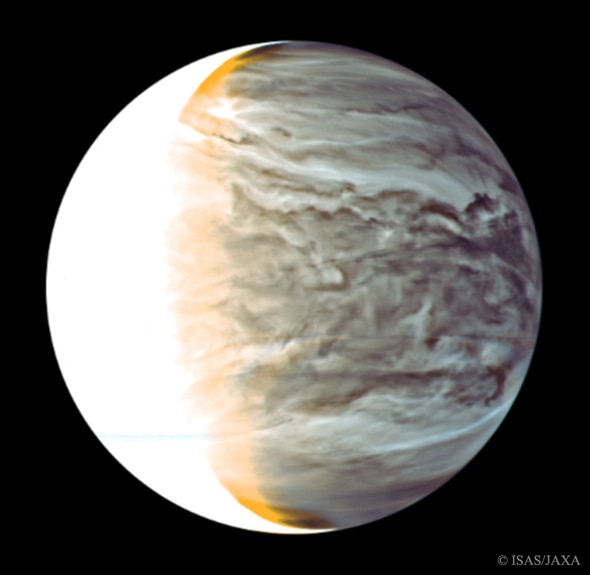Create a free profile to get unlimited access to exclusive videos, sweepstakes, and more!
Akatsuki Reveals a Hot, Dynamic Venus

That stunning image above really threw me for a moment. If I hadn’t seen the caption first, it seriously would’ve taken me a second or two to figure out what planet it must be.
That’s Venus. Honestly, I’ve never seen an image of our sister planet that looks anything quite like that (well, maybe just a little; see below). Usually Venus just looks, well, white. In visible light, at least, the kind our eyes see. Sometimes you can see subtle features, but nothing like this.
That shot was taken by the Japanese Akatsuki (“Dawn”) spacecraft, which entered Venus orbit in late 2015. This part is amazing: It was launched in March 2010 and arrived at Venus in December of that year, but due to a thruster misfiring it wound up not going into orbit around Venus initially. It orbited the Sun for five years, and incredibly engineers were able to insert it into Venus orbit using only its attitude control thrusters, very low thrust rockets used normally just to change the spacecraft’s angle to the planet. By doing so, they saved the mission.
And now Akatsuki is returning science to Earth. The image above is a combination of two infrared shots at wavelengths of 1.735 microns (shown as red) and 2.26 microns (shown as blue); a pseudo-green frame was crated combining the two together. The color choice is a bit odd, since usually the longer wavelength image is shown as red. But who am I to argue with such a phenomenal image?
The bright white crescent on the left is the day side of Venus, and the orange band is actually twilight; the ridiculously thick atmosphere of Venus (90 times the pressure of Earth’s atmosphere at ground level!) spreads out the sunlight, causing a wide band of scattered sunlight.*
But it’s the structure of the clouds on the night side of the planet that’s so amazing. The two different wavelengths used are sensitive to different sized cloud particles in Venus’ atmosphere and really show the atmospheric structure.
Venus is really odd: It rotates extremely slowly, taking 243 days to spin just once! The atmosphere, however, moves much more rapidly. At least, in the troposphere it does, up to a height of about 65 kilometers. It super-rotates, going around the planet faster than the planet spins. This effect is strongest at the equator, and decreases toward the poles. You can see that in the image; the sideways V-shape to the clouds reveals that.
In fact, I mentioned that the IR image does look a little like another one of Venus I’ve seen, in this case what it looks like in the ultraviolet:
That image was also taken by Akatsuki as it reached Venus orbit. You can also see the unusual pattern in the clouds there. Previous UV images have shown this as well.
The folks at the Japanese space agency JAXA also released this fascinating short animation showing the cloud motion:
That was taken in the infrared, four images taken four hours apart each. The motion you see is almost entirely due to the clouds super-rotating; Venus hardly spun at all during that time (the spacecraft was about 360,000 kilometers from the planet at the time, so its orbital velocity is low, and doesn’t contribute much to the motion seen either).
Akatsuki is still warming (haha) to its task at Venus. One of the most interesting things I’m waiting for is lightning data. Yes, seriously! Akatsuki has a Lightning and Airglow Camera that hopefully will settle a decades-long debate over whether Venus has lightning or not. That camera will be returning data pretty soon, so that’ll be nice to see.
Venus is such a fascinating place. Far hotter than Earth, an atmosphere that’s almost entirely carbon dioxide, tremendous surface pressure, a thick crust covered in volcanic features … it’s so close to being another Earth yet misses by a country kilometer. What happened? Why is it not Earth’s twin, but Earth’s evil twin? We’re still trying to figure that out, and Akatsuki will help tremendously.
Update, June 13, 2016: Mark McCaughrean, senior space adviser for the European Space Agency, reminded me that the ESA Venus Express probe also took amazing images of Venus. To be honest, this simply slipped my mind! I've thought about this before; we've had so many missions to so many planets now that it can be hard to remember them all. What times we live in! I've written about Venus Express many times, and because why not, here's NASA's Magellan mission, too.
*I used the auto-translate feature of Google to convert the original website’s description from Japanese, and it says the twilight band “is because that's near the day and night boundary has become Orange sexy,” which, honestly, I can’t argue with.


























